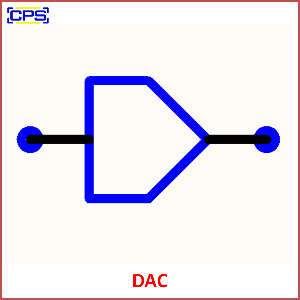A DAC (Digital-to-Analog Converter) is an electronic device that converts a digital signal (discrete data) into an analog signal (continuous signal). It enables digital systems to interface with analog devices by transforming binary data into a corresponding voltage or current output.

Key Features of a DAC:
- Input: Accepts digital data, typically in binary format.
- Output: Produces an analog signal proportional to the digital input.
- Resolution: Determines the precision of the output, measured in bits (e.g., 8-bit, 16-bit). Higher resolution provides finer detail in the analog signal.
- Conversion Speed: The rate at which the DAC can process and output signals.
- Linearity: Ensures the analog output accurately represents the digital input over the entire range.
Types of DAC:
- Binary-Weighted Resistor DAC: Uses resistors with binary-weighted values.
- R-2R Ladder DAC: Employs a repeating network of resistors for precision and simplicity.
- Sigma-Delta DAC: Uses oversampling and noise shaping for high-quality audio and signal conversion.
Applications:
- Audio Systems: Converts digital audio data into analog signals for speakers and headphones.
- Display Systems: Drives analog displays from digital data.
- Communication Systems: Generates modulated analog signals from digital data.
- Control Systems: Interfaces between digital controllers and analog actuators.
DACs are crucial in bridging the digital-analog divide, enabling seamless integration of digital and analog technologies.
